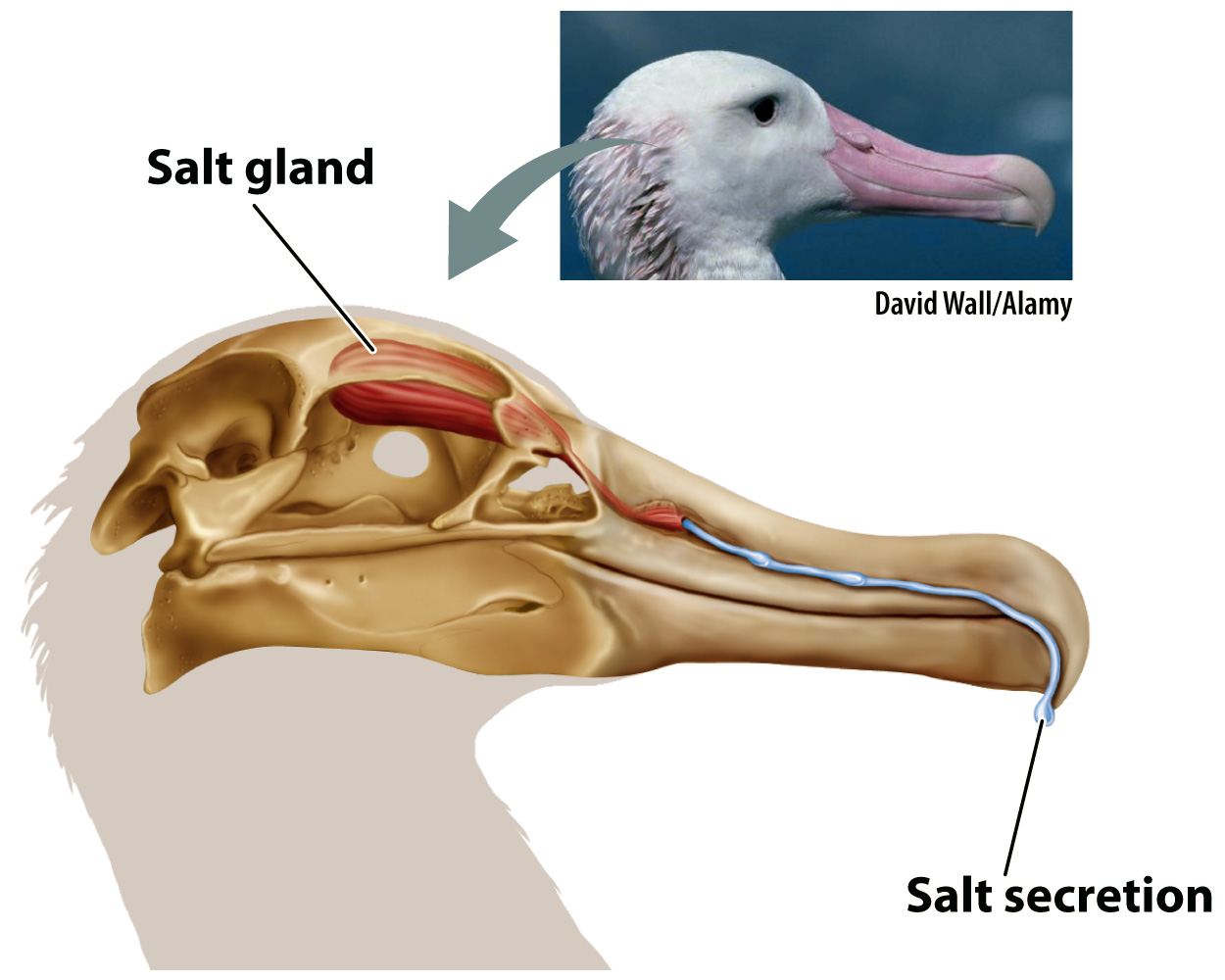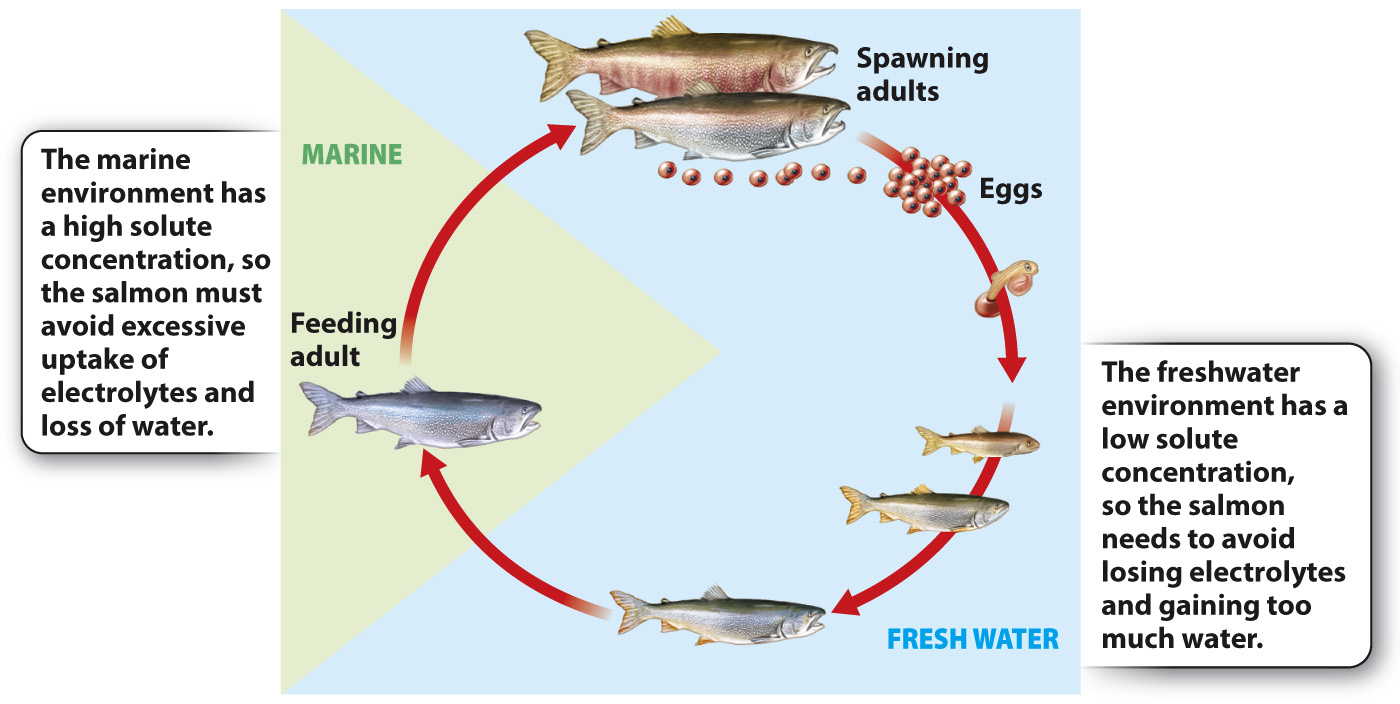Osmoregulators have internal solute concentrations that differ from that of their environment.
The second way in which animals achieve water and electrolyte homeostasis is by maintaining internal solute concentrations different from that of the environment. These animals are osmoregulators. Osmoregulators expend considerable energy pumping ions across cell membranes in order to regulate the movement of water into or out of their bodies. Some freshwater and marine fish that are osmoregulators are estimated to expend 50% of their resting metabolic energy on osmoregulation. However, the ability to regulate osmotic pressure allows osmoregulators to live in diverse environments—
Teleosts (or bony fish, the largest group of marine vertebrates) are osmoregulators. So are all freshwater and terrestrial animals. Marine bony fish maintain concentrations of electrolytes much lower than the surrounding sea water, whereas freshwater fish and amphibians maintain concentrations that are higher than the surrounding fresh water.
Let’s consider how osmoregulators achieve osmotic balance in salt water, in fresh water, and on land. In salt water, marine organisms live in an environment that is hypertonic relative to their internal fluids, like the cytoplasm of the cell, blood, and other internal fluids. These organisms maintain internal electrolyte concentrations lower than the surrounding salt water. They are thus faced with the problem of water loss (across their gills, as well as in their urine and feces) and electrolyte gain (across their gills and in seawater that they drink). As a result, they need to take in as much water as possible and eliminate excess electrolytes. They obtain water primarily through the food they eat and cellular respiration. They avoid water loss by producing concentrated urine (discussed in section 41.2).
Bony fish have evolved specialized gills that allow them to excrete excess electrolytes as well as to breathe. The thin gill filaments, with their extensive surface area, are useful sites for electrolyte transport out of the body in addition to being well adapted for gas exchange (Fig. 41.2). Specialized cells in the gills called chloride cells pump chloride ions into the surrounding seawater. By pumping negatively charged chloride ions out of the body, chloride cells create an electrical gradient that is balanced by positively charged sodium ions moving out of the body as well (Fig. 41.2a).

879
In fresh water, the environment is hypotonic relative to an organism’s internal fluids. In this case, the problem is just the opposite as that faced by marine organisms: water gain and salt loss. As a result, freshwater organisms tend to minimize their water intake and maximize water elimination. For example, in contrast to marine fish, they do not drink water. In addition, freshwater fish produce very dilute urine (discussed in section 41.2).
To maintain electrolyte concentration higher than the surrounding water, freshwater fish have gill chloride cells with reversed polarity relative to marine bony fish. Their chloride cells pump chloride ions (with sodium ions following) into the body to counter their ongoing loss from the gills into the surrounding fresh water (Fig. 41.2b).
Nearly all amphibians also live in freshwater environments and therefore face challenges similar to those facing freshwater fish. They take up electrolytes across their skin and produce dilute urine.
On land, the challenge is water loss. Terrestrial animals lose water in their urine and feces, through evaporation from their lungs, and, in humans, by sweating. To counter these losses, they drink water that is hypotonic relative to their body fluids. They also acquire water by eating food and by producing water during cellular respiration. They produce concentrated urine to minimize water loss.

Many marine birds have evolved specialized nasal salt glands to rid themselves of the high salt content of their diet (Fig. 41.3). These salt glands actively pump ions from the blood into the cells that make up the gland, and then excrete salt from the body through the gland and the nasal cavity. Their salt glands allow these birds to gain net water intake by drinking seawater. In contrast, humans and many other non–
880
An extreme example of the ability of an animal to regulate water and electrolyte levels is provided by the life cycle of salmon. Mature salmon swim in the salt water of the open ocean but return upriver to spawn in fresh water (Fig. 41.4). During the course of their return, they swim from high-

These changes in aquatic habitat demand that salmon make dramatic adjustments in the way they handle water and solutes. When in the ocean, salmon must avoid loss of water and uptake of electrolytes. However, when mature salmon migrate upriver to spawn and as young salmon continue to grow in freshwater streams and rivers, the challenge is reversed: They must avoid gaining too much water and losing critical electrolytes across their gills. In salmon, radical changes in osmoregulation are required over the course of an animal’s lifetime to enable it to reproduce in freshwater streams and return to the sea for further growth and maturation. Next, we explore how gills and kidneys meet these challenges.